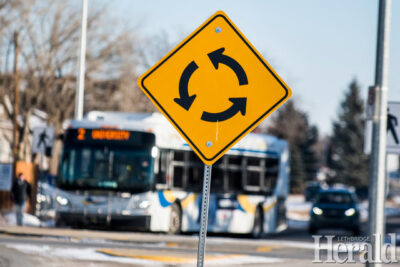BILD working with City for best use of roundabouts
By Al Beeber - Lethbridge Herald on January 5, 2022.
 Herald photo
A city transit bus and other traffic navigate through the roundabout at 28 Street and 28 Avenue South.
Herald photo
A city transit bus and other traffic navigate through the roundabout at 28 Street and 28 Avenue South.LETHBRIDGE HERALDabeeber@lethbridgeherald.com
As 1980s hair metal band Ratt once sang “out on the streets, that’s where we’ll meet.” And in Lethbridge that often means at roundabouts. In newer residential areas and on major roads, city drivers will inevitably come across a roundabout during their weekly travels.
Love ’em or hate ’em, roundabouts are here and the Building Industry & Land Development Association (BILD) Lethbridge region is working with the City to ensure the best use of roundabouts is made.
At the Dec. 2 meeting of the Civic Works Standing Policy Committee of city council, a joint presentation was made on roundabouts by city engineer Byron Buzunis and BILD executive officer Bridget Mearns.
The two discussed with committee members the Planning Roundabout Guide which was developed with input from, and a review by BILD. They also talked about the subject from different perspectives.
Advantages of roundabouts, the guide says “reduced traffic conflict points, less delay, fewer and less accidents.”
Disadvantages include “potential land requirements, capital costs and parking restrictions.”
For builders, developers and home owners, roundabouts in residential areas have impacts, Mearns said recently in a phone interview.
“There was wording in the transportation safety plan that the goal was to increase the number of roundabouts and that was a concern – just having a goal to increase roundabouts didn’t seem very thoughtful,” said Mearns.
“This is why it was necessary to have these thoughtful conversations about where they go. There’s definitely some learning. I’m hopeful that we now have a more thoughtful process. There is still no doubt about it their (the City’s) preference is roundabouts but at least there’s an opportunity to make the argument that they’re not appropriate either for cost impact on land or function of design. It’s a more thorough discussion,” said Mearns.
Among concerns of roundabouts is the delay they can cause emergency responders to reach a residence, an issue addressed at the SPC meeting by councillor John Middleton-Hope. Mearns says homes in areas built outside of a 10-minute response time from a fire station have to be built differently which could add up to $20,000 to the cost of a home.
“That’s why it’s important when they’re looking at putting in fire stations that they’re managing to capture as much of the area as they can in 10 minutes. So when you start adding these roundabouts in the way of the fire, from the fire station to the surrounding area, you could be affecting the response time” and also the cost of future development, Mearns said.
Roundabouts also affect the design of neighbourhoods, eliminating the ability for homeowners to have front garages and street parking, she said. Large roundabouts can take up as much space as three building lots, reducing the number of homes that can be built in a neighbourhood.
She said they can serve as a gateway to a neighbourhood but once inside “they don’t make a whole lot of sense. We’re looking for a process to evaluate them.”
Mearns says roundabouts also aren’t necessarily safer for pedestrians and cyclists.
The city has a complete street strategy which it developed years ago and which BILD will be working with them on, focusing on design standards, Mearns said.
“It talks about implementing multi-modal so this looks at putting in bike lanes but where do we put in those bike lanes? And if there are roundabouts, how are we going to put those bikes lanes in so bicyclists and families are safe in those lanes? It’s important that we have a really solid conversation where are we putting these roundabouts and what are the impacts,” she said.
Among considerations are land use efficiency as well as the impact on home owners, builders and on the city which has to maintain infrastructure, she said.
“These are the kind of things we’ve asked to be part of the guidelines and be part of the process where a roundabout would be,” said Mearns.
“This is an internal process where the industry has the opportunity and administration have that more guided dialogue about what they’re going to look at when they consider roundabouts.
“This is a really good example of how we’ve come together as an industry, voiced our concerns and we’ve worked with the city to hopefully come with a process that can meet the objectives in the municipal development plan, the objectives of council as well as building a city that’s thoughtful and quality and considers how home owners and our citizens move in our city.
“I was quite thrilled to see the work that they came with us and did with us to come up with these guidelines. It was thoughtful, it was methodical, it was respectful so the next step is these guidelines will be tested the next time there’s an outline plan,” Mearns said.
“Then we’ll re-evaluate it from there.”
Follow @albeebHerald on Twitter
4-3




